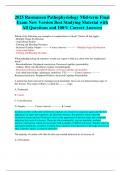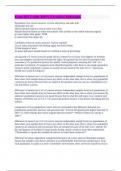2025 Rasmussen Pathophysiology Mid-term Final
Exam New Version Best Studying Material with
All Questions and 100% Correct Answers
Which of the following are examples of complications of shock? (Select all that apply)
- Multiple Organ Dysfunction
- Acute Renal Failure
- Clotting and Bleeding Disorders
- Increased Cardiac Output ---------- Correct Answer ----------- - Multiple Organ Dysfunction
- Acute renal failure
- Clotting and Bleeding disorders
What pathophysiological responses would you expect to find in a client who has anaphylactic
shock?
- Bronchodilation, Peripheral constriction, Decreased capillary permeability
- Asthma, Deep vein thrombosis, hepatic encephalopathy
- Bronchoconstriction, peripheral dilation, increased capillary permeability
- Left-sided heart failure, pulmonary embolism, UTI ---------- Correct Answer -----------
Bronchoconstriction, Peripheral Dilation, Increased Capillary Permeability
A patient has been exposed to meningococcal meningitis, but is not yet demonstrating signs of
this disease. This stage of illness is called the ______ stage.
A. Prodormal.
B. Latent.
C. Convalescence.
D. Sequela. ---------- Correct Answer ------------ B. Latent.
Incubation refers to the interval between exposure of a tissue to an injurious agent and the first
appearance of signs and symptoms. In infectious diseases, this period is often called the
incubation (latent) period. Prodromal refers to the appearance of the first signs and symptoms
indicating the onset of a disease. These are often nonspecific, such as headache, malaise,
anorexia, and nausea, which are associated with a number of different diseases. Sequela refers to
subsequent pathologic condition resulting from a disease. Convalescence is the stage of recovery
after a disease, injury, or surgical operation.
The majority of cardiac cells that die after myocardial infarction do so because of:
A. Cell rupture.
,B. Thrombus.
C. Insufficient glucose.
D. Apoptosis. ---------- Correct Answer ------------ D. Apoptosis.
MI results when prolonged or total disruption of blood flow to the myocardium causes cellular
death by necrosis or apoptosis. Cardiac cells do not die as a result of cellular rupture. Insufficient
glucose is not associated with myocardial death. The initiating event of MI is believed to be
related to thrombus, but the resulting disruption of flow to the myocardium is because of necrosis
or apoptosis.
Tumor necrosis factor α and interleukin-1 contribute to shock states because they induce
production of:
A. Clotting factors.
B. Nitric oxide.
C. Catecholamines.
D. Vasopressin. ---------- Correct Answer ------------ B. Nitric oxide.
In septic shock, tumor necrosis factor-α, interleukin-1, and other inflammatory mediators induce
vascular cells to produce excessive amounts of the vasodilator nitric oxide. Catecholamines are
not produced by TNF-α and IL-1. The production of clotting factors is not induced by tumor
necrosis factor-α and interleukin-1. Vasopressin production is not induced by TNF-α and IL-1.
Which clinical manifestation is not likely the result of a tuberculosis infection?
A. Productive cough
B. Low-grade fever
C. Cyanosis
D. Night sweats ---------- Correct Answer ------------ D. Cyanosis.
Cyanosis is not a typical manifestation of tuberculosis infection. A productive cough, low-grade
fever, and night sweats are the typical manifestations of tuberculosis infection.
Renal compensation for respiratory acidosis is evidenced by:
A. Elevated CO2.
B. Decreased CO2.
,C. Elevated HCO3- concentration.
D. Decreased HCO3- concentration. ---------- Correct Answer ------------ C. Elevated HCO3-
concentration.
Elevated bicarbonate ion concentration is evidence of compensation for a respiratory acidosis.
The lungs manage the carbon dioxide concentration. Elevated carbon dioxide is evidence of
respiratory acidosis, not of compensation for it. Decreased bicarbonate ion concentration would
make acidosis worse.
Lusitropic impairment refers to:
A. Poor contractile force.
B. Impaired diastolic relaxation.
C. Altered action potential
conduction rate.
D. Altered automaticity. ---------- Correct Answer ------------ B. Impaired diastolic relaxation.
Lusitropic impairment refers to an energy-requiring process that removes free calcium ions from
the cytoplasm by pumping them back into the sarcoplasmic reticulum and across the cell
membrane into the extracellular fluid. Ischemia interferes with this process in the active phase of
diastolic relaxation. Poor contractile force is not associated with lusitropic impairment. The
conduction rate is not associated with the energy-requiring process known as lusitropy.
Automaticity is not a factor in lusitropy.
Apoptosis is a process that results in cellular:
A. Mutation.
B. Atrophy.
C. Proliferation.
D. Death. ---------- Correct Answer ------------ D. Death.
Apoptosis results in death of a cell when it is no longer needed. Atrophy refers to reduction in
size of an organ because of cellular shrinkage. Proliferation refers to growth of new cells.
Mutation refers to alteration in the genetic structure of cellular DNA.
Airway obstruction in chronic bronchitis is because of:
A. Loss of alveolar elastin.
, B. Pulmonary edema.
C. Hyperplasia and deformation of bronchial cartilage.
D. Thick mucus, fibrosis, and smooth muscle hypertrophy. ---------- Correct Answer ------------
D. Thick mucus, fibrosis, and smooth muscle hypertrophy.
Airway obstruction in chronic bronchitis is as a result of thick mucus, fibrosis, and smooth
muscle hypertrophy. Loss of alveolar elastin, pulmonary edema, and hyperplasia and
deformation of bronchial cartilage are not part of the pathophysiology of chronic bronchitis.
A patient is diagnosed with heart failure with normal ejection fraction. This patient is most likely
characterized by a(n):
A. Elderly woman without a previous history of MI.
B. Young female athlete with cardiomegaly.
C. Middle-aged man with a previous history of MI.
D. Young sedentary male with a high-stress job. ---------- Correct Answer ------------ A. Elderly
woman without a previous history of MI.
Heart failure with normal ejection fraction is particularly likely to develop in the elderly, in
women, and in those without a history of MI. A middle-aged man with a previous history of MI
may have heart failure, but the older woman fits the criteria of heart failure with normal ejection
fraction. A young female athlete with cardiomegaly may experience heart failure, but is not the
normal patient profile for this condition. A young sedentary male with a high-stress job may
experience heart failure, but this patient does not fit the normal profile for this condition.
The relationship of blood flow (Q), resistance (R), and pressure (P) in a vessel can be expressed
by which equation?
A. Q = R/P
B. R = PQ
C. P = Q/R
D. Q = P/R ---------- Correct Answer ------------ D. Q = P/R.
The relationship between the variables of pressure and resistance is expressed by Ohm's law: Q =
P/R. Q is the blood flow, P is the pressure difference, and R is the resistance. Ohm's law is Q =
P/R. R = PQ is not the expression for the relationship between blood flow, resistance, and
pressure. P = Q/R is not the correct expression reflecting Ohm's law.





